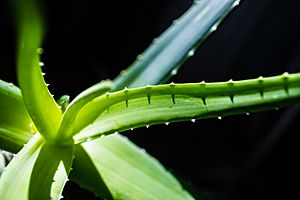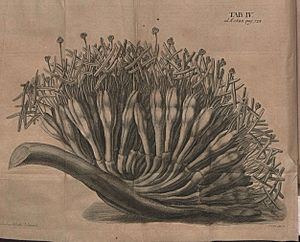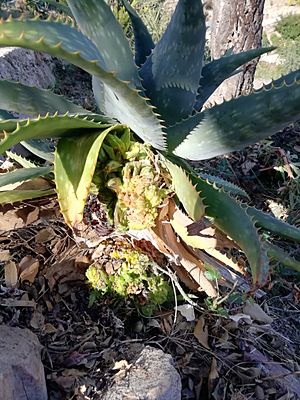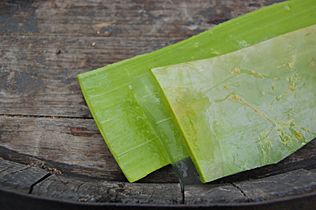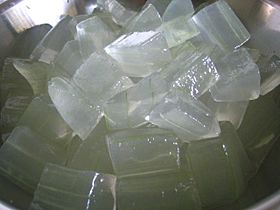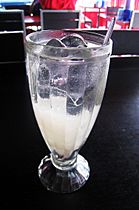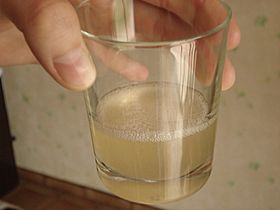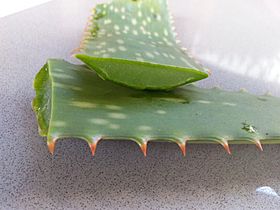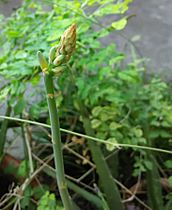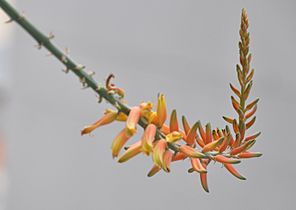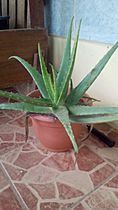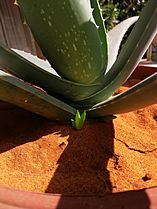Aloe vera facts for kids
Quick facts for kids Aloe vera |
|
|---|---|
 |
|
| Plant with flower detail inset | |
| Scientific classification | |
| Synonyms | |
|
Aloe vera is a type of succulent plant. It belongs to the Aloe group of plants. This plant is found in many places around the world. Sometimes, it grows so well that it can take over areas where it isn't native.
This plant stays green all year round. It originally comes from the Arabian Peninsula. But now, it grows naturally in warm, dry places worldwide. People grow it to make products, especially for skin care. Aloe vera is also a popular potted plant for homes.
The leaves of Aloe vera contain a special gel. This gel has a substance called acemannan. People use this gel on their skin. The outer skin of the aloe leaf has a substance called aloin. This substance can be harmful. So, products usually only use the clear gel from inside the leaf.
Many products contain Aloe vera gel. These include skin lotions, makeup, and gels for small burns or scrapes.
It is important not to eat Aloe vera extracts. Eating them can cause problems that scientists are still studying. Some people can also have skin reactions, like a rash, even when they put the gel on their skin. Always check with an adult or doctor before using any plant for health reasons.
Contents
What is the Name Aloe vera?
The name Aloe comes from an Arabic word. It means "bitter and shiny substance." It might also come from a Hebrew word for a similar plant. The second part of the name, vera, is Latin. It means "true." So, Aloe vera means "true aloe."
Other Names for Aloe vera
People often call Aloe vera by other names. These names often include a place where it grows. For example, you might hear "Chinese aloe" or "Barbados aloe."
How Scientists Classify Aloe vera
Scientists have given Aloe vera a few different names over time. Some old names include Aloe barbadensis and Aloe indica. The plant was first officially described in 1753. This was done by a famous scientist named Carl Linnaeus.
Scientists use DNA to study how plants are related. DNA studies show that Aloe vera is similar to Aloe perryi. This plant grows in Yemen. Other studies suggest it's also related to plants from Somalia and Sudan. Because Aloe vera doesn't have many natural wild groups, some think it might be a mix of different plants.
What Does Aloe vera Look Like?
Aloe vera plants usually don't have a stem, or they have a very short one. They can grow up to 60 to 100 centimeters (about 2 to 3 feet) tall. They spread by growing small new plants, called "offsets," around the main plant.
Aloe vera Leaves
The leaves are thick and full of gel. They are green or grayish-green. Some types have white spots on their surfaces. The edges of the leaves have small, white, saw-like teeth.
Aloe vera leaves contain many natural chemicals. Scientists are studying these chemicals. They want to see if they have any special effects on the body.
Aloe vera Flowers
In summer, Aloe vera grows tall spikes. These spikes can be up to 90 centimeters (about 3 feet) tall. Yellow, tube-shaped flowers hang down from these spikes. Each flower is about 2 to 3 centimeters (about 1 inch) long.
Aloe vera Roots
Like other Aloe plants, Aloe vera roots form a special partnership with tiny fungi in the soil. This partnership helps the plant get more nutrients from the ground.
Where Does Aloe vera Grow?
Aloe vera is believed to be native to the southeastern Arabian Peninsula. It grows in the Hajar Mountains of Oman and the United Arab Emirates. However, people have planted it all over the world. It now grows wild in places like North Africa, Sudan, the Canary Islands, and parts of Spain and Portugal.
In the 1600s, Aloe vera was brought to China and parts of southern Europe. Today, it grows naturally in many dry, warm, and tropical areas. Its wide spread is likely because people have grown it for so long.
How to Grow Aloe vera
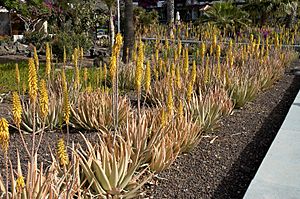
Aloe vera is a very popular plant for gardens and homes. Gardeners like it because it's a useful medicinal plant. They also like its interesting look and flowers. Since it's a succulent, it can live in places with little rain. This makes it great for gardens that don't need much water.
This plant can survive in warm climates. It does not like heavy frost or snow. Aloe vera is usually strong against most bugs. But sometimes, tiny pests like spider mites or mealy bugs can harm it. Aloe vera has won an award for being a great garden plant.
If you grow Aloe vera in a pot, it needs sandy soil that drains well. It also needs lots of bright sunlight. Too much direct sun can make the leaves turn red, like a sunburn. It's best to use a special soil mix for cacti and succulents. Clay pots are good because they let the soil breathe.
Only water your potted Aloe vera when the soil is completely dry. The main plant often grows small "pups" or baby plants. You can separate these pups and plant them in their own pots. Or, you can leave them with the mother plant. In winter, Aloe vera might slow down its growth. It needs less water then. If you live where it gets cold, keep your Aloe vera indoors.
Large amounts of Aloe vera are grown in many countries. These include Australia, Mexico, India, and the United States. Much of this Aloe vera is used to make beauty products.
What is Aloe vera Used For?
Aloe vera provides two main things: a clear gel and a yellow liquid called latex. The clear gel is often used in skin products. These products help with skin problems like burns, wounds, rashes, or dry skin. The yellow latex is sometimes used in products to help with constipation.
There are different ideas about how well Aloe vera works for wounds or burns. Some studies suggest that using aloe products on the skin might help with certain skin issues. But remember, some people can have an allergic reaction to it.
Aloe vera gel is also used in some foods. You might find it in yogurts, drinks, and desserts. However, eating too much aloe latex or whole leaf extract can be harmful. Using small amounts of Aloe vera gel on the skin is usually safe.
Aloe vera for Skin and Possible Side Effects
You can find Aloe vera in lotions, gels, soaps, and makeup. These products are for putting on your skin. If someone is allergic to Aloe vera, they might get a skin rash. They could also have trouble breathing or swelling in their face.
Aloe vera as a Supplement
A substance called Aloin is found in the yellow latex of some Aloe plants. This substance used to be in some laxative medicines in the United States. But in 2002, it was no longer allowed because companies couldn't prove it was safe.
Eating Aloe vera can be harmful. It can cause stomach aches or an upset stomach. Eating large amounts of aloe for a long time can cause more serious health problems.
Some Aloe vera juices are sold to help with digestion. But there is no strong scientific proof that they work. Also, the amounts used in these juices can be harmful.
Traditional Uses of Aloe vera
People have used Aloe vera in traditional medicine for a very long time. Records show it was used as far back as 4,000 years ago. It was also mentioned in old books from 512 CE.
Aloe vera in Everyday Products
Aloe vera is added to many everyday products. You might find it in facial tissues, makeup, moisturizers, soaps, and shampoos. It's often included because it helps to moisturize and soften the skin.
Is Aloe vera Harmful?
Eating Aloe vera leaf extract that hasn't been processed can be harmful. Some studies suggest it might cause health problems if eaten. This is because of certain chemicals in the plant.
Since 2016, a group of scientists has said that whole Aloe vera leaf extract might possibly cause cancer in humans.
Using Aloe vera on the skin is generally safe. It usually doesn't cause serious problems. But eating Aloe vera can be harmful. It might cause stomach cramps and an upset stomach. This can also stop your body from taking in other medicines properly.
Gallery
-
Gel used for desserts
See also
 In Spanish: Aloe vera para niños
In Spanish: Aloe vera para niños


